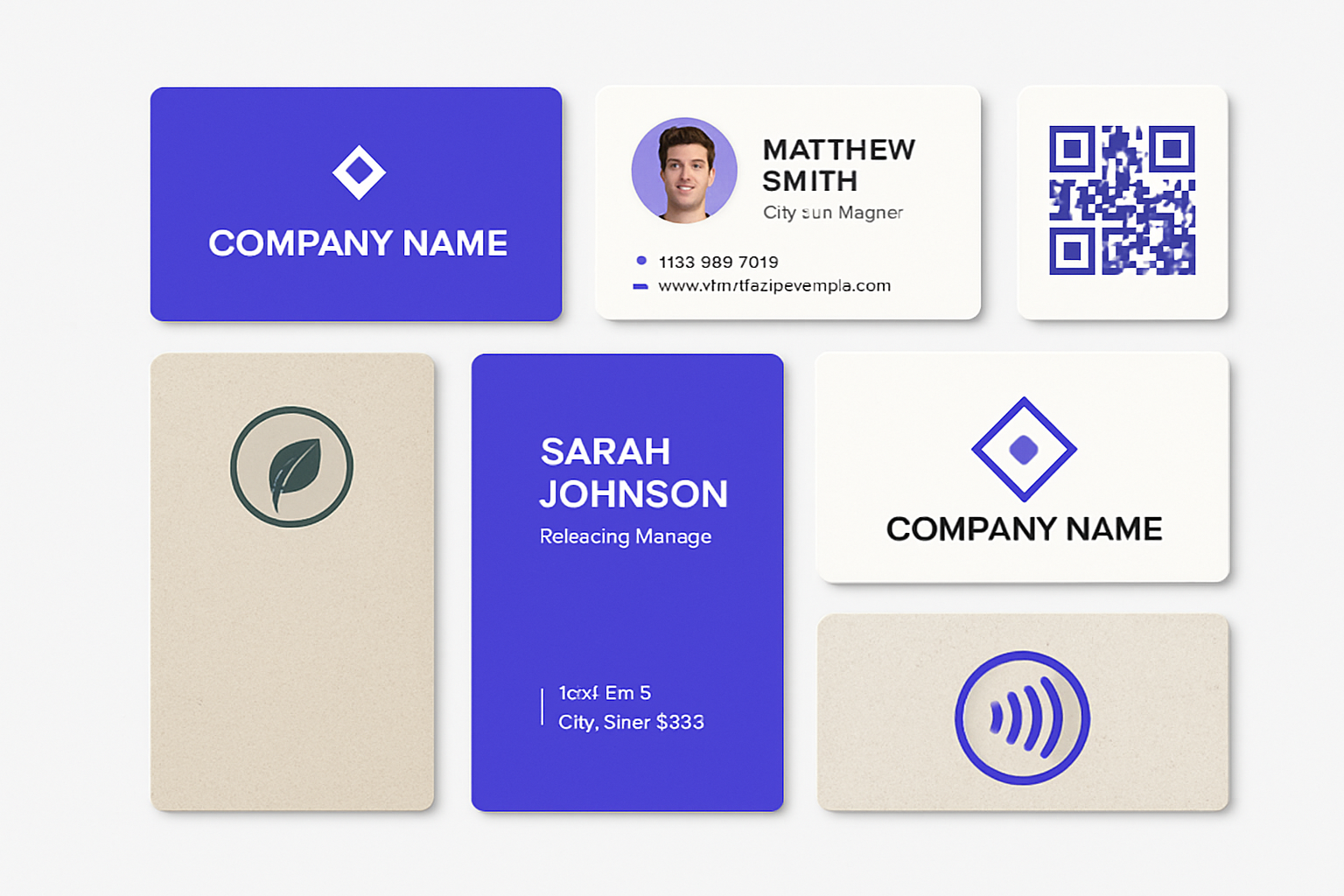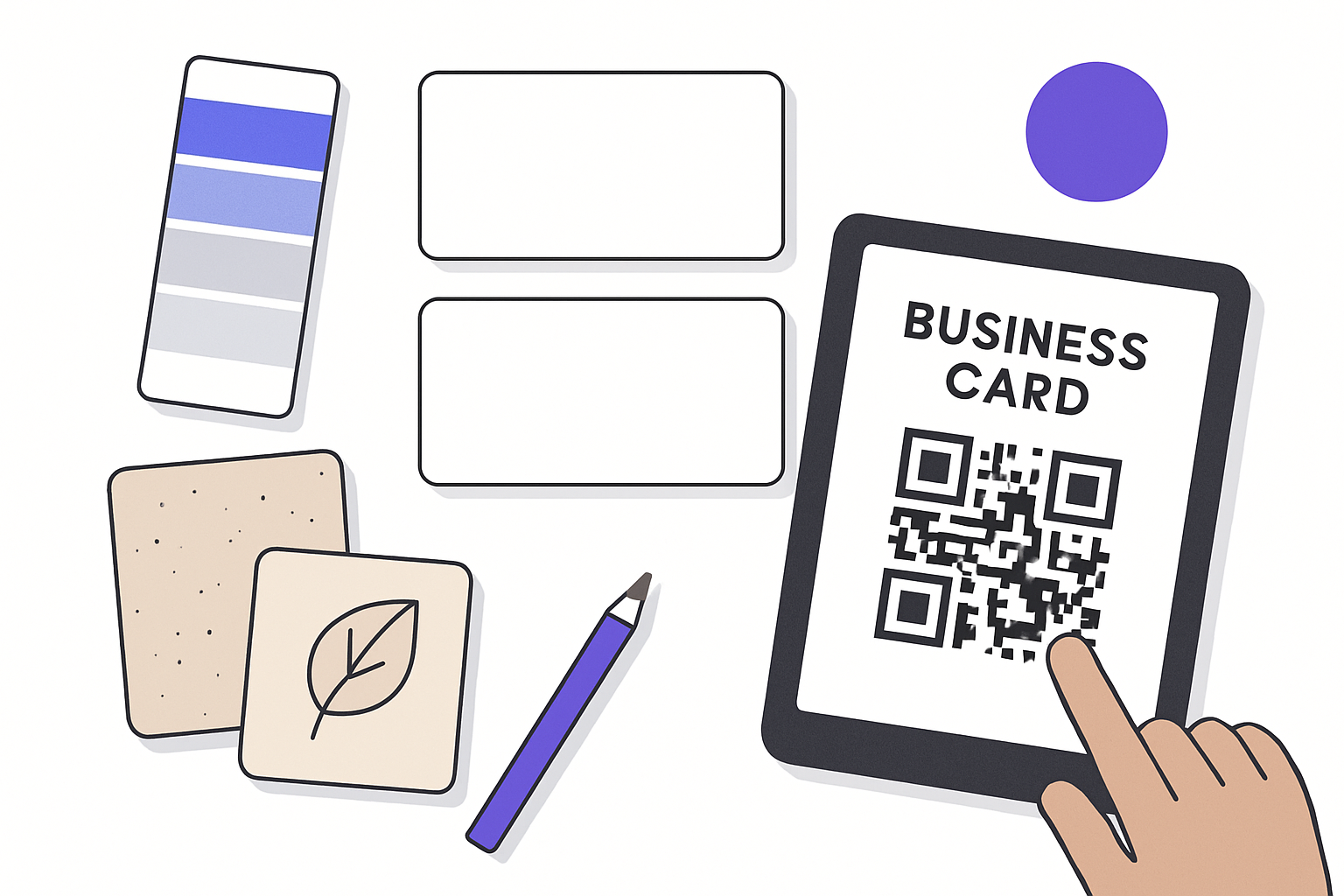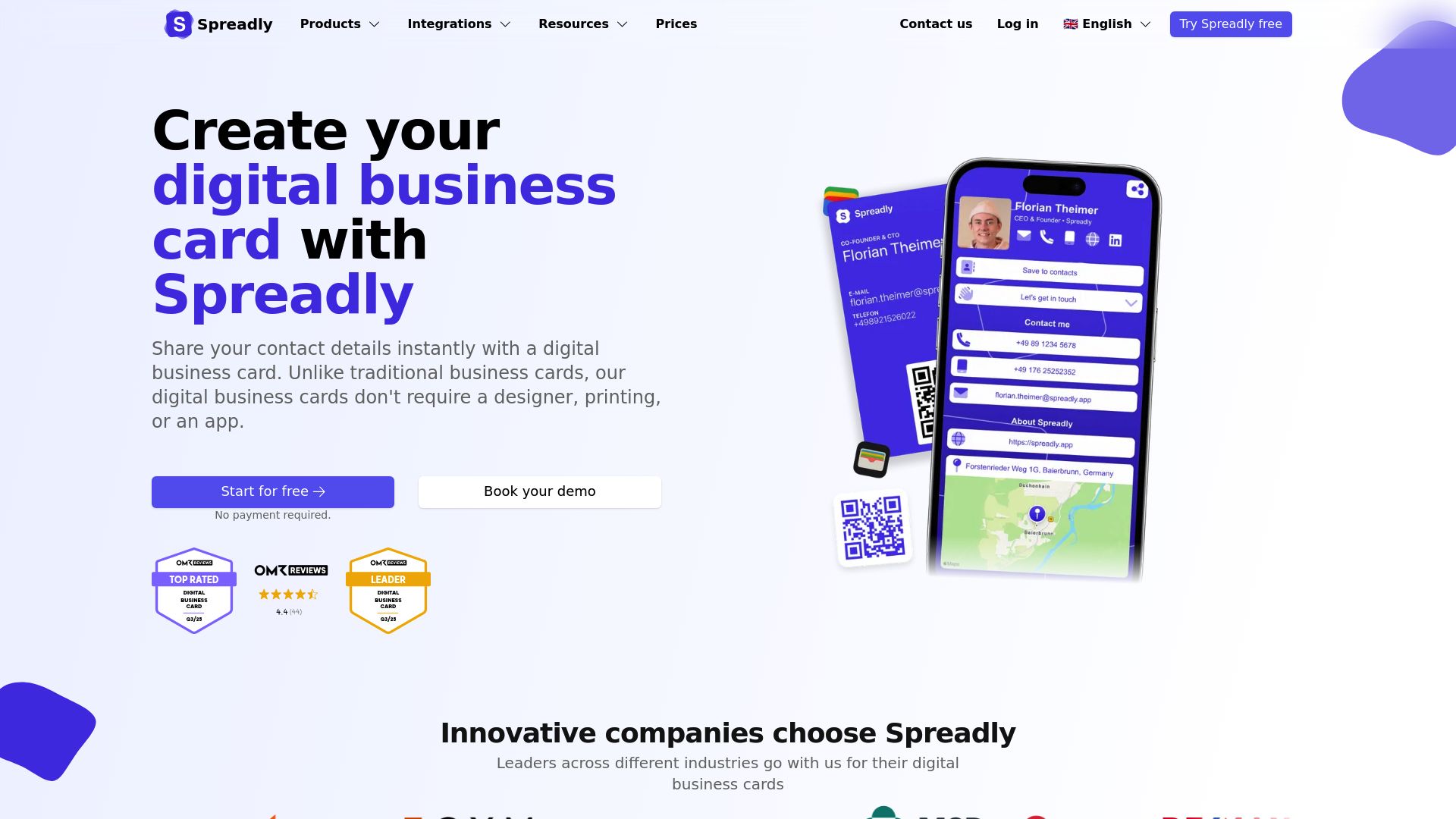Business Card Personalised Guide for Professionals 2025
13 minutes
11th of October 2025
In this article:
- The Evolving Role of Business Cards in 2025
- Essential Elements of a Personalised Business Card
- Step-by-Step Guide: Creating Your Personalised Business Card in 2025
- Maximising Networking Impact with Personalised Cards
- Digital Business Cards: The Future of Personalised Networking
In today’s fast-paced world, first impressions count more than ever. Your business card personalised to reflect your unique style is no longer just a formality, it’s your brand’s handshake.
This guide is tailored for professionals seeking to stand out in 2025’s evolving networking landscape. Discover the latest trends, essential design elements, and digital innovations that elevate your presence.
With actionable steps and expert insights, you’ll learn how to design, customise, and leverage your business card for maximum professional impact. Let’s unlock the potential of your personal brand together.
The Evolving Role of Business Cards in 2025
In 2025, the business card personalised experience remains a cornerstone of professional networking. Despite digital disruption, business cards continue to bridge the gap between first impressions and lasting connections. Their tactile nature and thoughtful design convey professionalism and attention to detail—qualities that digital-only interactions often lack.

The Enduring Importance of Business Cards
The business card personalised to reflect your professional identity is still a powerful networking tool. While digital platforms continue to grow, face-to-face meetings demand a tangible exchange. According to a 2023 CreditDonkey study, 72% of professionals admit to judging others by the quality of their business cards. This underscores the card’s role in shaping perceptions.
A well-crafted business card makes interactions memorable. It serves as a physical reminder of a conversation, often sparking follow-ups that digital connections might miss. In a world where attention is fleeting, the right card can set you apart instantly.
| Statistic | Insight |
|---|---|
| 72% | Judge by card quality (CreditDonkey, 2023) |
New Expectations and Trends in Personalisation
Today’s business card personalised approach goes beyond classic layouts. The rise of hyper-personalisation means professionals now incorporate custom designs, unique QR codes, and even personal taglines or social handles. Cards often feature photos or avatars for instant recognition.
Sustainability also shapes choices, with eco-friendly materials and digital alternatives gaining traction. Industry leaders are integrating interactive elements and bold branding to reflect their unique value. For a deeper dive into these innovations, explore the latest Business Card Design Trends 2025.
Personalisation trends ensure your business card personalised for 2025 leaves a lasting impression, whether in print or digital form.
Digital Transformation: From Paper to Pixels
The business card personalised for the digital era is rapidly evolving. Over 30% of professionals now use digital business cards, leveraging NFC and QR code technology for instant information sharing (Statista, 2024). These features make it easy to update details and connect seamlessly.
Hybrid cards, which blend physical and digital elements, are on the rise. They allow professionals to cater to diverse networking environments, offering the best of both worlds. This flexibility is crucial as remote and in-person meetings coexist.
By adapting to digital trends, a business card personalised for modern workflows ensures its relevance and reach.
The Professional’s Perspective
Different professions demand unique business card personalised features. For example:
Creatives may use bold colors and interactive elements.
Tech professionals often prioritize NFC or QR integrations.
Legal and sales experts focus on classic design and clear information.
Case studies show that innovative companies tailor their cards to fit industry expectations, driving better networking results. The right business card personalised for your field demonstrates not just contact details, but an understanding of what your peers value most.
The Business Impact
A business card personalised with attention to detail can directly influence business outcomes. LinkedIn Pulse (2023) reports that personalised cards lead to 2.5x higher follow-up rates in B2B networking compared to generic designs.
Enhanced brand recall and trust are also key benefits. Thoughtful personalisation, whether through design, messaging, or material, reinforces your professional identity. In a competitive landscape, the business card personalised to your brand is an investment in every connection you make.
Essential Elements of a Personalised Business Card
A business card personalised for 2025 is more than a simple contact slip. It’s a strategic extension of your professional brand. Each detail—from the information you display to the materials you choose—affects how you are perceived in every networking interaction.

Core Information Every Card Needs
At its core, a business card personalised for modern professionals must include your full name, job title, company, and up-to-date contact details. In 2025, social media handles or a professional website are often essential additions.
Striking the right balance between minimalism and informativeness is key. Too little information can make follow-ups difficult, while too much can overwhelm the recipient. Ask yourself: Does each element on your business card personalised for your goals serve a clear purpose?
Design Fundamentals
The design of your business card personalised for your brand should reflect professionalism and consistency. Prioritize legible typography using clean, modern fonts. Font size matters—avoid text that’s too small or cluttered.
Color psychology is crucial. Choose colors that align with your brand image and industry. Logo placement should be prominent but not overpowering. For inspiration, explore Minimalist Business Card Designs to see how simplicity and elegance can make a lasting impression.
Personalisation Features
Customizing your business card personalised for recognition means going beyond the basics. Consider adding a professional photo or avatar, which can boost face-to-name recall. Include a tagline or a concise value proposition.
Interactive elements are a major trend. QR codes can link directly to your portfolio or LinkedIn profile, while NFC chips enable instant contact sharing. For more ideas, see how Interactive Business Card Features are reshaping networking in 2025.
Material and Finish Choices
The material of your business card personalised for sustainability and style matters. Popular choices include premium paper stocks, textured finishes, and recycled materials. Digital card platforms are gaining traction for their eco-friendliness and flexibility.
Compare options:
| Material Type | Key Benefit | Ideal For |
|---|---|---|
| Recycled Paper | Eco-friendly | Green brands |
| Textured Cardstock | Tactile appeal | Luxury brands |
| Digital/NFC | Instant sharing | Tech sectors |
Choose the format that aligns best with your audience and your business card personalised strategy.
Compliance and Accessibility
A business card personalised for compliance ensures you respect privacy regulations such as GDPR. Only include information you’re comfortable sharing publicly.
Accessibility is essential. Use high-contrast fonts, tactile features for the visually impaired, and offer language options where appropriate. These details allow your business card personalised for 2025 to reach and serve a wider audience with professionalism.
Examples of Standout Cards
Innovative designs set the best business card personalised examples apart. Creative professionals may use bold colors and custom illustrations, while tech leaders favor digital cards with embedded links.
Hybrid cards—combining print and digital—are rising. For example, a lawyer’s card with tactile embossing and a discreet QR code blends tradition with modern convenience. Comparing traditional, digital, and hybrid cards reveals that the most effective business card personalised for today’s landscape always matches its owner’s unique brand and networking needs.
Step-by-Step Guide: Creating Your Personalised Business Card in 2025
Designing a business card personalised for your unique professional journey requires a strategic, thoughtful approach. In 2025, standing out means more than just sharing your contact information. This practical guide will walk you through each essential step, ensuring your card is not only memorable but also a powerful networking tool.

Step 1: Define Your Purpose and Audience
Before you create a business card personalised to your needs, clarify your networking objectives. Are you aiming for new clients, job opportunities, or brand partnerships? Your purpose shapes every design and content decision.
Identify your target audience. For instance, an entrepreneur may require a bold, creative card, while a corporate professional might favor a sleek, minimal look. Consider what your recipients expect and value most in a business card personalised for their industry.
Ask yourself:
What outcome do I want from sharing my card?
Who will I meet most often: clients, recruiters, or peers?
What impression should my card leave?
Defining these factors ensures your business card personalised strategy aligns with your career goals and audience expectations.
Step 2: Gather and Organise Your Information
A successful business card personalised for 2025 must include core details: your name, job title, company, email, and phone number. Add extras like a website, social media, or a QR code linking to your portfolio.
Accuracy matters. Forbes reports that 40% of business cards still carry outdated information—a costly mistake in modern networking. Ensure every detail aligns across your digital and physical platforms.
Tips for organising your information:
Double-check spelling, job titles, and contact details.
Use a consistent format for phone numbers and email addresses.
Keep optional elements (social handles, taglines) relevant to your goals.
A business card personalised with up-to-date, well-organised info will help you build trust and credibility instantly.
Step 3: Choose Your Format—Physical, Digital, or Hybrid
Selecting the right format is crucial for an effective business card personalised to your workflow. Each type offers distinct advantages:
| Format | Pros | Cons |
|---|---|---|
| Physical | Tangible, memorable, ideal for events | Can be lost, less eco-friendly |
| Digital | Easy updates, interactive features | May lack personal touch |
| Hybrid | Best of both worlds, greater flexibility | Slightly higher setup effort |
Consider your audience: tech professionals may value digital cards, while traditional sectors still prefer printed versions. Hybrid solutions are gaining traction at conferences, combining the impact of a tangible card with the convenience of instant sharing.
Weigh the environmental impact and practicality. The right format makes your business card personalised to both your values and your professional context.
Step 4: Select Design Elements and Personalisation Features
Next, focus on the creative aspects that make your business card personalised to your brand. Choose a color palette and fonts that reflect your professional identity. For 2025, integrating personal branding—like your logo, tagline, or even a professional photo—sets you apart.
Interactive features are on the rise. Add QR codes that link to your portfolio, calendar, or LinkedIn. NFC chips offer instant contact sharing. Tailor messaging to your unique value proposition.
Best practices for design:
Use readable, professional typography.
Balance whitespace and content for a clean look.
Ensure logo and colors are consistent with your wider brand.
A business card personalised with these thoughtful features leaves a lasting impression and invites further engagement.
Step 5: Design and Customise Your Card
Whether you use a template or partner with a designer, your business card personalised design should balance creativity with professionalism. DIY design tools like Canva and Adobe Express offer flexible templates, while custom layouts allow for unique branding.
Tips for effective customisation:
Preview designs in both digital and print formats.
Test different layouts for optimal information flow.
Solicit feedback from colleagues or mentors.
Remember, a business card personalised to your goals should reflect both your personality and your industry’s expectations. Don’t overcrowd the card—clarity always wins.
Step 6: Print or Generate Your Card
Choose a reputable printer or digital card provider for the final step. Quality matters: review proofs and request test prints or digital previews to ensure accuracy.
Sustainability is a growing priority. Many professionals now opt for recycled paper, soy-based inks, or digital alternatives. For more insights on eco-friendly materials and trends, explore Sustainable Business Card Materials.
A business card personalised with sustainable materials not only reflects environmental responsibility but also appeals to like-minded contacts.
Step 7: Distribute and Share Effectively
Distribution is where your business card personalised strategy meets real-world results. Share your cards at networking events, client meetings, and conferences. Add your digital card to email signatures and digital wallets for seamless, modern sharing.
Track engagement with digital solutions—analytics can reveal open rates, shares, and follow-up opportunities. Statista notes a 45% increase in digital card shares from 2022 to 2024, highlighting the shift toward smarter networking.
A well-distributed business card personalised for your professional landscape maximises your reach and helps you convert contacts into meaningful connections.
Maximising Networking Impact with Personalised Cards
A business card personalised for your brand is more than a simple handoff—it's a strategic tool for building connections. In today’s fast-paced professional landscape, the right design and approach can transform a brief exchange into a lasting opportunity.
Making a Memorable First Impression
Your business card personalised for your industry is often the first tangible representation of your brand. A thoughtfully crafted card can spark conversation and set the tone for a meaningful exchange.
Consider cards with bold colors, striking logos, or interactive elements like QR codes. These features invite curiosity and make you stand out from the crowd. When you present a business card personalised to reflect your values and personality, you immediately communicate professionalism and attention to detail.
Handing over your card with a brief story or context, such as highlighting a unique service or achievement, adds impact. This approach makes the introduction memorable and increases the likelihood of a follow-up.
Leveraging Technology for Follow-ups
In 2025, a business card personalised for digital engagement can streamline post-event follow-ups. Embedding QR codes or NFC chips enables instant saving of contact details, linking directly to your online portfolio or scheduling tool.
This seamless experience eliminates manual data entry and allows recipients to act on your information immediately. Integrating your business card personalised with CRM systems or networking apps ensures that every connection is efficiently tracked and nurtured.
Prompt follow-up messages referencing your meeting and the distinct features of your card reinforce your brand and keep the conversation moving forward.
Tracking Engagement and ROI
A business card personalised with digital capabilities provides valuable analytics to measure networking success. Digital cards can track when your contact details are viewed, shared, or saved.
| Metric | What It Shows | Impact |
|---|---|---|
| Open Rate | How often your card is viewed | Measures interest |
| Share Rate | Frequency of card forwarding | Expands your reach |
| Lead Capture | New contacts generated | Direct ROI |
These insights allow you to refine your business card personalised strategy, focus on high-value connections, and demonstrate the tangible benefits of your networking efforts.
Real-World Success Stories
Many professionals have elevated their careers using business card personalised solutions. For example, a creative director added a portfolio QR code, leading to multiple freelance projects after networking events.
Companies report up to 60% higher brand recall using business card personalised designs with interactive features. These success stories underscore how customisation and technology can turn simple introductions into concrete opportunities.
By sharing your story or data-driven results, you inspire trust and credibility with new contacts.
Common Mistakes to Avoid
Even the best business card personalised can fall short if common pitfalls are overlooked:
Overloading the card with too much information.
Using inconsistent branding or unprofessional design.
Forgetting to update outdated contact details.
Neglecting accessibility or privacy requirements.
Avoid these errors to ensure your business card personalised remains an asset, not a liability. Prioritise clarity, relevance, and regular updates for ongoing networking success.
Digital Business Cards: The Future of Personalised Networking
The rise of digital solutions has reshaped how professionals present themselves and connect. In 2025, the business card personalised for your unique identity is not just a trend—it’s becoming an essential tool for modern networking. Digital business cards offer flexibility, instant updates, and a seamless experience that bridges the gap between in-person and virtual connections.
Key Advantages of Digital Business Cards
Digital business cards provide a host of advantages that set them apart from traditional paper cards. A business card personalised for the digital age supports instant updates, so your contact details are always current.
Eco-friendly: No paper waste, supporting sustainability goals.
Cost-effective: No need for repeated printing, making them ideal for teams.
Rich media support: Embed videos, portfolios, and lead forms for a dynamic introduction.
Accessibility: Share your card instantly via link, QR code, or NFC tap.
With a business card personalised for your needs, you can ensure your information is always accurate and accessible. This adaptability is invaluable for professionals who attend multiple events or change roles frequently. As networking evolves, these cards make it easy to stay ahead.
Advanced Features and Integrations
What sets digital cards apart is the range of advanced features and integrations now available. A business card personalised for today’s technology can sync with calendars, CRMs, and even AI-powered contact managers.
Scheduling integration: Book meetings directly from your card using tools like Calendly.
CRM connectivity: Automatically add new contacts to your database.
AI business card scanners: Instantly capture and organize leads.
Security and privacy: Full control over data sharing and GDPR compliance.
These features allow professionals to streamline follow-ups and measure engagement. When your business card personalised for your brand includes smart integrations, you transform a simple introduction into a powerful networking tool.
Modern Digital Business Card Solutions: Spreadly
Spreadly stands out as a leading platform for creating a business card personalised for both individuals and teams. With Spreadly, you can design custom digital cards without any design or printing required.

Share anywhere: Use personal links, QR codes, NFC, or even add your card to Google and Apple Wallet.
Custom branding: Upload logos, set fonts, and choose interactive backgrounds.
Lead capture: Built-in forms, scheduling, and product embeds to boost engagement.
Team automation: HR integrations and CRM sync for enterprise needs.
Compliance: Fully GDPR-compliant and Europe-focused.
Professionals and enterprises using Spreadly report higher engagement and smooth networking at global events. To explore these features, visit Spreadly's digital business card page.
Choosing the Right Digital Card Platform
Selecting the best platform for your business card personalised experience requires careful consideration. Compare features, branding options, integrations, and privacy controls to find the right fit.
| Platform | Branding Options | Integrations | GDPR Compliance | Ease of Use |
|---|---|---|---|---|
| Spreadly | Extensive | CRM, HR | Yes | High |
| HiHello | Moderate | CRM | Yes | High |
| Mobilo | Limited | CRM | Yes | Medium |
A business card personalised for your goals should offer easy updates, strong branding, and robust security. According to Gartner, 55% of enterprises plan to switch to digital cards by 2025, reflecting the growing need for modern networking solutions.
If you’re ready to elevate your networking game and put the insights from this guide into action, there’s no better time to explore what a modern, personalised business card can do for your professional presence. With Spreadly, you can create a tailored digital card that’s always up to date, brand-aligned, and ready to share in seconds—no printing or design skills needed. Experience firsthand how easy it is to impress contacts and capture leads wherever you go. Why not take the next step and try for free? Your future connections are just a click away.






